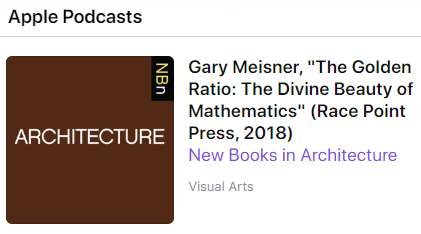Gary B. Meisner, author of the website GoldenNumber.net and developer of PhiMatrix software, did an interview on the New Books Network (NBN) for his 2018 book, “The Golden Ratio – The Divine Beauty of Mathematics.”
The interview was conducted by Tricia Keffer, as host for NBN’s Architecture Podcast. The podcast aired on November 23, 2019. Coincidentally, this is celebrated by some as Fibonacci Day as the date 11/23 corresponds to the first digits in the Fibonacci sequence of 1, 1, 2, 3. (Some references start with zero). NBN is in the top 2% of podcast downloads.
Questions that Tricia posed in the interview included:
- What is the Golden Ratio, aka Phi, and why is it important to understand and study?
- Can you talk about some examples of divine ratio in Architecture?
- Can you talk about how paintings are designed? Seurat and Monet, Da Vinci?
- Where else can we find divine ratios in nature? Why is it important?
- What about the design of musical instruments? I’ve noticed that even my pen has a divine proportion to it.
- What is your favorite golden mean and Phi research topics?
- In your book, you included a section for the skeptics. What do you say to them about the meaning of your research?
The interview was fast-paced and engaging, and its 40 minute duration allowed for a deep dive into some of the topics, especially as it related to where the golden ratio appears in architecture and how it can be applied by architects, and anyone else in the design arts.
Classic applications of the golden ratio include some of the most notable buildings in the world, including the Parthenon, the Taj Mahal and the UN Secretariat Building. It was even used in the futuristic design of Star Trek’s USS Enterprise.
One of the key takeaways, for architects or for anyone in the design arts, is that any design or composition they create involves many decisions on position and proportion. The golden ratio, with its unique mathematical properties and inherent harmony of proportions, provides a tool like no other to incorporate visual harmonies into all aspects of their designs.
- Leonardo da Vinci used this technique in his composition of The Last Supper and Salvator Mundi.
- Michelangelo used it in his composition and design of the many paintings on the Sistene Chapel.
- Google used it when it announced a complete revision in 2015 of its logos, icons and website layouts.
- Although not covered in the interview, cartoonist Steven Silver (of Disney, Sony and Nickelodeon) even uses it in his creation of cartoon characters. He refers to the golden ratio as his “secret weapon of design” The golden ratio prevents him “from making things so even.” He’s refers to this as “avoiding the ladder” in describing the tendency to create identical spacing in design and composition, which “makes everything feel so ordinary.” He notes that the golden ratio, by contrast, is flawless because it gives the “small, medium and large” that good design is built upon.
As Meisner pointed out in the interview, using the golden ratio may seem somewhat limiting at first, but it’s really not. Consider that just 12 notes of the musical scale have been used to create limitless songs and styles of music. Yes, there are many other frequencies that could be used, but what can be created from those 12 notes is limited only by your creativity, and all the music ever composed with the Western musical scale is in harmony with that design, and thus inherently familiar to the ear. The same is true of the golden ratio. It can be applied to every decision being made on position and proportion, and the creative results are truly unlimited. This makes it far better than the “Rule of Thirds,” which is a simple way to approximate the golden ratio, but that lacks many of its benefits.
Meisner also discussed the historical applications of the golden ratio in architecture, its appearances in nature, and a number of topics that are most subject to confusion and debate.
Tricia shared that her professor, Dr. Chang, learned about the golden ratio and its applications from his art training at the Beau Arts School in Paris. His hero was Leonardo da Vinci. While he now has a golden mean caliper, he had learn it first by doing geometric constructions with a string. Tricia intends to use the golden ratio in her career in landscape architecture, which is certainly another great application for it use.